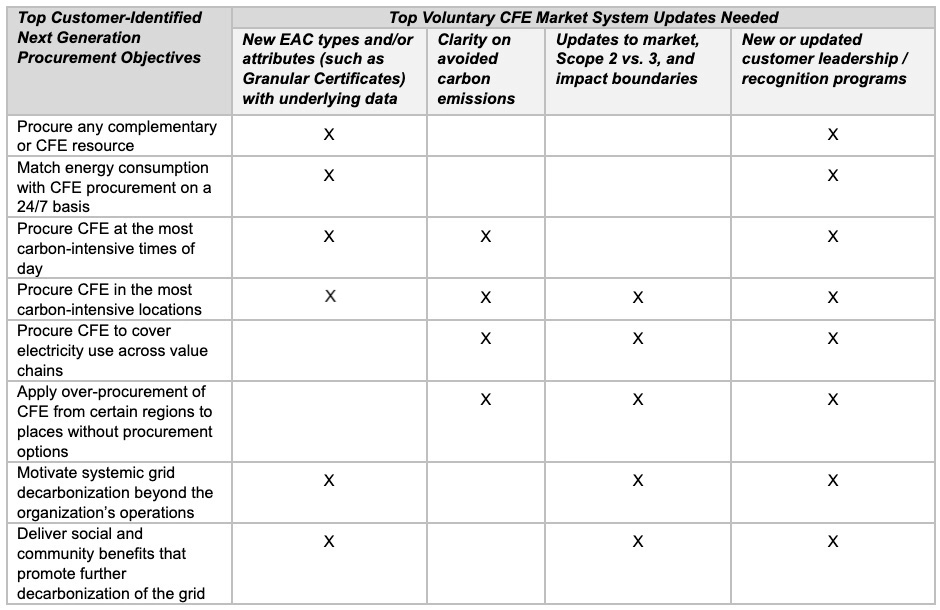Energy Customers and Solution Providers Identify Key Market Updates to Enable Next Generation Procurement Options

The Clean Energy Buyers Institute’s NextGen Activator Workshop series identifies energy market gaps and changes necessary to help energy customers advance toward and optimize the decarbonization impact of their clean energy procurement.
Energy customers and solution providers have clarified the key updates required for evolving the current system underlying the voluntary carbon-free electricity (CFE) procurement market. These updates, if addressed, will advance the introduction of new procurement options to help customers optimize the decarbonization impact of their procurement decisions. During the second workshop in the NextGen Activator workshop series, convened by the Clean Energy Buyers Institute (CEBI), more than 70 energy customers and solution providers offered input on the changes necessary to the current system of energy attributes, data, greenhouse gas accounting frameworks, and leadership recognition programs to introduce solutions that help customers achieve the top eight objectives for next generation CFE procurement.
Table 1 summarizes the overall types of market updates needed to support new types of voluntary CFE procurement options so customers can maximize the decarbonization impact of their procurement decisions. There are four key areas of opportunity to update to the current voluntary market system to unlock new CFE procurement options:
- New or updated customer leadership and recognition programs: Common to all customer objectives is the opportunity to evolve existing or create new customer recognition programs, such as the UN’s 24/7 CFE Compact targeting 24/7 voluntary procurement, that encourage and acknowledge the implementation of new CFE procurement practices. Recognition programs are important because they validate the importance of certain procurement options, inform company goal setting, and showcase the associated achievements of companies.
- New energy attribute certificate (EAC) types and/or attributes with underlying data: Customers seeking new EAC types and/or attributes that capture more CFE resources (e.g., nuclear energy, efficiency energy, demand response), complementary resources (e.g., long- and short-term storage), and more attributes such as granular timestamps, grid carbon intensity, and supportive social/community impacts (e.g., jobs created by a CFE resource, community ownership information, and environmental and social impact-related certifications). Each of these EACs require access to different data sources to ensure the quality of the attribute being captured by the EAC.
- Clarity on avoided carbon emissions: Customers seek clearer guidance on the use of avoided emissions as a criterion for CFE procurement decisions and greenhouse gas accounting. For example, if a customer procures CFE during the most carbon-intensive times of day or in the most carbon-intensive locations to achieve its own decarbonization target, then this customer needs to know how to account for this type of procurement for its annual greenhouse gas inventory.
- Updates to market, Scope 2 vs. 3, and impact boundaries: There are several types of “boundaries” that must evolve (or dissolve) to enable customers to procure more CFE. New and/or expanded boundary definitions are needed to enable customers to over-procure CFE in certain geographies to cover their inability to procure CFE in other geographies with limited or unavailable CFE options, power more parts of their value chain (both upstream and downstream) with CFE to reduce their Scope 3 emissions, and capture efforts where a customer’s engagement with utilities, governments, or regulators help change the overall grid mix.
Table 1: Key CFE Market Updates Needed to Enable Customer-Identified Next Generation Procurement Options

Let’s dive into three specific examples to further illustrate how and why these market system updates will enable new types of procurement options:
- Example 1, CFE procurement on an hourly basis: For a company that wants to match their CFE procurement with their actual real-time load, there is a need for EACs that provide granular timestamps and for these timestamped EACs to synchronize with EAC registries/issuing bodies. Nonprofit EnergyTag has advanced quickly with industry stakeholders to develop the Granular Certificate Scheme Standard and Use Case Guidelines. CEBI is collaborating with EnergyTag and serving on its Advisory Committee.
- Example 2, CFE procurement based on maximum avoided emissions potential: For a company that wants to consider avoided emissions in their procurement decisions, they need access to quality data about the avoided emissions potential of different decisions, the ability to support avoided emissions claims through suitable EACs, and clarity as to if/how avoided emissions can count toward reducing its annual greenhouse gas emissions.
- Example 3, CFE procurement for value chains: For a company that wants to procure CFE to reduce its Scope 3 emissions by covering the electricity use associated with its suppliers and/or its customers’ use of the company’s products/services, greater clarity is needed on how to apply EACs across value chains to reduce customers’ Scope 3 emissions and how recognition programs can incentivize customers to procure CFE for their value chains.
In the coming months, CEBI will continue to unpack the detailed requirements for each of these market system updates and clarify the specific parties best positioned to implement these updates. CEBI will also further characterize customer needs for next generation procurement in order to support solution providers in preparing to deliver new CFE solutions to customers as these market updates are implemented. CEBI invites customers, solution providers, and voluntary market system stakeholders to the third NextGen Activator workshop on May 18th in-person at our Spring Summit in Detroit (registration here), which will inform open questions about the role of avoided emissions in CFE procurement decision making and greenhouse gas accounting and reporting.
